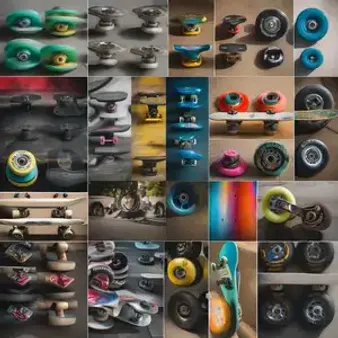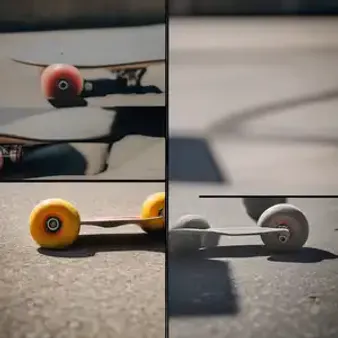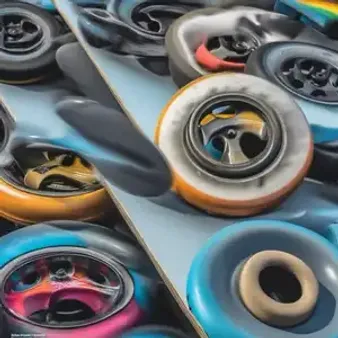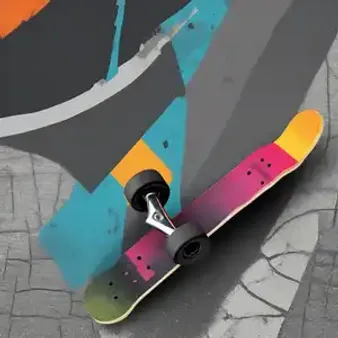Table of Contents
Navigating the world of skateboarding can feel like learning a whole new language, especially when it comes to different skate wheels. What's the deal with hardness? Does size really matter? At kizworld, we're here to break down the mystery of different skate wheels and help you find the perfect fit for your board and riding style.
Wheel Feature | Description | Ideal For |
|---|---|---|
Hardness (Durometer) | Measured on the A scale (e.g., 99A, 101A). Higher numbers indicate harder wheels. | Softer wheels (78A-87A) for rough surfaces and longboarding. Harder wheels (88A-101A+) for smooth surfaces, street skating, and parks. |
Size (Diameter) | Measured in millimeters (mm). | Smaller wheels (50-53mm) for street skating and technical tricks. Larger wheels (54mm+) for cruising, ramps, and longboarding. |
Shape | Varies from narrow to wide, with rounded or square edges. | Rounded edges for smoother slides and transitions. Square edges for more grip and control. |
Brand | Numerous brands cater to different skating styles and preferences. | Research popular brands like Spitfire, Bones, Ricta, and OJ Wheels to find the best fit for your needs. |
Different Skate Wheels for Different Rides
Alright, imagine this: you wouldn't wear your muddy hiking boots to a fancy dinner party, right? It's the same with skate wheels! Different wheels are made for different types of skating. If you're all about carving up the streets, showing off your how to heelflip, or hitting the skate park, you'll want harder wheels. These bad boys are super durable and let you roll fast and smooth on those pristine surfaces. Think of them like the race cars of the wheel world. On the flip side, if cruising along the boardwalk or bombing down hills is more your style, softer wheels are your new best friend. They're like the comfy SUVs of the skate world, built for a smoother ride over rougher terrain.
Different Skate Wheels for Different Rides
Hardness: The Core of Skate Wheel Choice
Okay, so you're ready to roll with the right wheels, but where do you even start? It all comes down to hardness, my friend. Picture this: You wouldn't want to bounce a bowling ball on a trampoline, would you? That's kinda what it's like trying to skate on super hard wheels on a rough surface. Hardness is measured with something called a durometer, and it's rated on the "A" scale.
Lower numbers like 78A to 87A mean the wheels are softer, like marshmallows ready to cushion your ride. They're perfect for cruising over cracks and bumps, making them a great choice if you're into longboarding or just want a smooth glide. Higher numbers, on the other hand, mean harder wheels. Think 88A to 101A or even higher! These are your speed demons, built for smooth surfaces like skate parks or freshly paved streets. They're fast, grippy, and perfect for nailing those sweet tricks.
Decoding the Durometer: Soft vs. Hard Wheels
Imagine trying to ride a skateboard with shopping cart wheels – not gonna be a smooth ride! That's why choosing the right wheel hardness is super important. Soft wheels act like mini shock absorbers, soaking up the bumps and vibrations from the ground. Remember that time we went skating by the beach? My soft wheels glided right over those cracks in the pavement, while you were rattling your teeth on your hard wheels!
Now, hard wheels are a different story. They're built for speed and precision. Think of them like the tires on a race car – they need to grip the road for those tight turns and quick maneuvers. If you're into street skating, hitting ramps, or practicing your kickflips at the skatepark, hard wheels are your go-to. They might not be as forgiving on rough surfaces, but on smooth ground, they'll have you flying!
Hardness | Ideal For |
|---|---|
78A - 87A (Soft) | Rough surfaces, longboarding, cruising, beginners |
88A - 101A+ (Hard) | Smooth surfaces, street skating, skateparks, ramps, tricks |
Hardness: The Core of Skate Wheel Choice
Size Matters: Finding the Right Skate Wheel Diameter
Now, let's talk wheel size! Just like your shoe size, skate wheel diameter matters. We measure this in millimeters (mm), and it can seriously affect how your board rolls. Smaller wheels, like those around 50-53mm, are like zippy little go-karts. They're awesome for quick turns, technical tricks, and street skating. Remember when you were learning to kickflip? Smaller wheels made those pop and flick tricks way easier! But if you're all about speed and cruising, think bigger – like 54mm and up. These larger wheels are like the monster truck tires of the skate world, perfect for rolling over cracks and bumps, hitting ramps, or enjoying a smooth longboarding experience.
Size Matters: Finding the Right Skate Wheel Diameter
Beyond the Basics: Exploring Other Skate Wheel Factors
Now that we've tackled hardness and size, let's explore some other key factors that can fine-tune your ride. Think about the shape of the wheel. Rounded edges, also known as radiused edges, are like the smooth talkers of the wheel world. They offer less friction, making slides and transitions buttery smooth. If you're into street skating or hitting up the skatepark, grinding, rounded edges are your best bet. On the other hand, square or sharp edges provide maximum grip, like the cleats on a soccer player's shoes. These are great for beginners who want more control and stability or for skaters who need that extra grip for powerful maneuvers.
And don't forget about the core! The core is the center part of the wheel that attaches to your bearings. Different core designs affect the weight, speed, and durability of your wheels. Some cores are solid, providing maximum strength and support, while others have cutouts to reduce weight and improve roll speed. It's like choosing between a sturdy hiking boot and a lightweight running shoe – it all depends on your needs and preferences.
Shape | Best For |
|---|---|
Rounded Edges | Smooth slides, transitions, street skating, skateparks |
Square/Sharp Edges | Grip, control, beginners, powerful maneuvers |
Beyond the Basics: Exploring Other Skate Wheel Factors
Final Thought
Choosing the right skate wheels can truly transform your ride. From smoother slides to faster speeds, the right set of wheels will match your style and skill level. Remember to consider the terrain, your skating goals, and personal preferences when making your decision. Now that you're armed with this knowledge, go out and enjoy the ride!